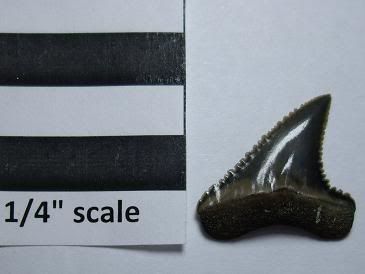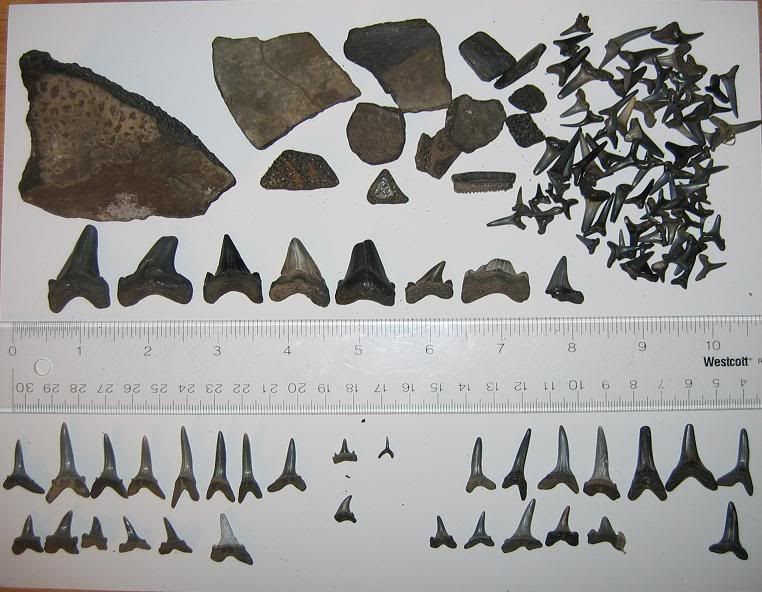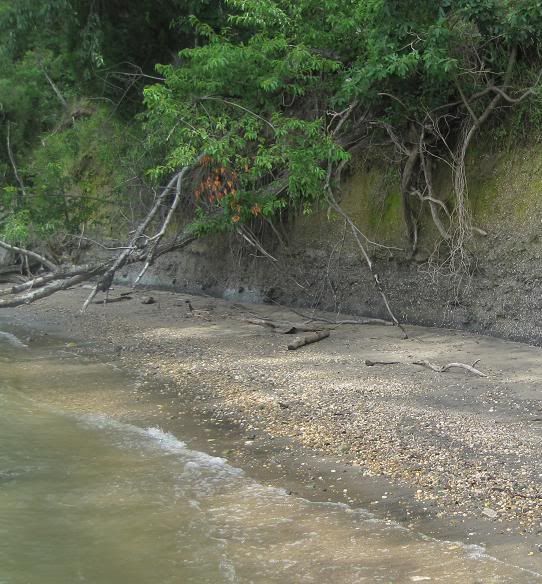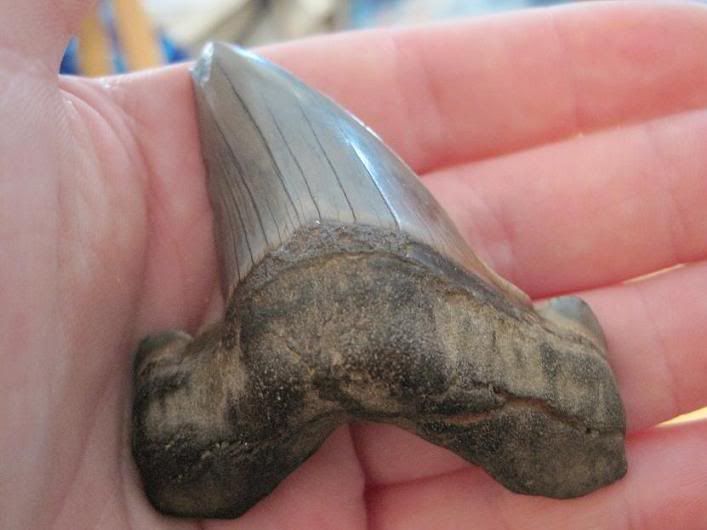Dave Roberts boated this chunky bass
while finessing with a 4" plastic worm.
One of my goals yesterday was to pitch jigs and catch fish with my new fathers day present (flippin rod and reel). Well, I met half the goal and got some pitchin' in, but didn't get a fish on it. I think that cold front conditions, clear water, and that we were fishing lots of areas that were devoid of the type of cover you'd like to pitch to contributed to that. I'm satisfied that I gave it a good effort. I know that big fish tactics like that pay off as they have for me in the past, but yesterday it was not to be. We made several passes down a particular productive lake shoreline, found fish and knew they were there. Each time we worked that stretch of shoreline we caught fish while finesse fishing, but other normally productive techniques didn't even draw a strike. This is how finesse fishing techniques for bass can really make your day when fish just seem that they don't want to bite your usual stuff.
What tackle works well for finessing largemouth? There are many ways to finesse bass, but when I think finesse, I'm thinking light line, light weight and soft plastic lures. Spinning gear with a high quality fast action graphite rods in medium light to medium power and a quality reel with a good drag set properly generally will suffice for putting bass in the boat using these techniques. I let water clarity determine what type of line that I use. In most cases I prefer 8 pound fluorocarbon line for sinking presentations when the water is clear. For floating presentations I may use monofilament because mono line floats. When the water is murky I'll go with small diameter braided line to get a little better hook setting power and that extra line strength to muscle the fish in a bit more. I'll go into more detail on lure types and the amount of weight that I use in a moment, but in general I'd say that the amount of weight for most of these presentations varys from no weight up to about a 3/8 of an ounce. Wind, depth, and the type of cover that you fish may dictate how much weight you'd use, but also the effect you want to have on your lure may determine that as well. For example, more weight means a faster fall while lighter weight means the opposite. It all depends on what you want the fish to see to trigger a strike. As an overall rule, I use just enough weight to get the effect I want while still reaching the bottom, but not so much weight that the fish will drop the lure when they bite. I find that while fishing these techniques the fish tend to grab and hold on to the lure much longer than faster heavier power presentations.
Finesse techniques include those popular in the bass fishing world that pro anglers and publications have made famous. One thing that they all have in common is that they use light line, generally light weight, and they draw strikes when other lure presentations don't. Shaky worm fishing, drop shotting, weightless presentations such as floating worms or sinking stickbaits, flukes and small plastic worms are many of the techniques that these pros use. Let's now go into more detail.
Mark McWilliams (left) coaxed this
largemouth to hit his shaky head rig.
|
Shakey worms and shaky heads (sometimes spelled shakey in the marketplace) have become popular over the past several years. The terminology is new, but the concept is as old as soft plastics. The concept is that you fish a soft plastic lure on light line while keeping the lure in the strike zone where you know bass will hang out, and shake it in their face. Technology of equipment and tackle selections have improved dramatically over the years allowing anglers fishing finesse techniques to really build up their arsenal. In general, light weight jigheads designed to rig soft plastics weedless while enabling those plastics to "stand up" are quite popular and effective for shaky worm fishing. Most shaky worm anglers rigs include straight worms that often tend to float the tail up rather than sink to the bottom. The stand up worm approach raises the tail of the worm off the bottom increasing visibility to fish. Shake it a little and tempt that bass to strike. The lure resembles a critter feeding on the bottom.
There are many styles of shaky heads on the market. Some of them have screw locks built into the head, a short section of coiled wire molded to the jigead designed so that you can screw the plastic worm head to the jighead and bury the hook into the body of the worm Texas style rendering the rig weedless. Some shaky heads appear to many like any other jighead, but have flat bottoms , special hook and eye alignment design, or other features that allow the jig to stand up on end and prop the plastic tail up off the bottom.
There are many styles of shaky heads on the market. Some of them have screw locks built into the head, a short section of coiled wire molded to the jigead designed so that you can screw the plastic worm head to the jighead and bury the hook into the body of the worm Texas style rendering the rig weedless. Some shaky heads appear to many like any other jighead, but have flat bottoms , special hook and eye alignment design, or other features that allow the jig to stand up on end and prop the plastic tail up off the bottom.
Drop Shotting is a popular technique. Simplified, the basic rig includes a sinker on the end of the line with a hook and small soft plastic lure tied a couple feet up your line, or whatever depth you want to present the bait. Of course, now there are specialized products for the technique that enable you to change weights without retying, hooks that stay straight and keep your lure presented horizontally, and rods that are designed for this technique that have sensitivity and backbone while still being able to cast light lures effectively. This technique is effective when you want to have an off the bottom presentation that allows fish to see your bait easily. These rigs also allow you to fish vertically and keep the lure moving to draw strikes from inactive bass. Soft plastics of all kinds are effective with this technique including small plastic worms (some designed just for drop shotting), creature imitations in the form of preys species like gobies, minnows, and crawfish, and also can be used as an effective presentation for tube baits.
Wacky rigs are also very effective on inactive bass. You can wacky rig any type of soft plastic, but the most popular plastics rigged this way include soft sinking stick baits in the Senko style, french fry type worms, and straight tailed finesse worms. You can wacky rig them on a drop shot set up, weightless on a small circle or octopus hook, or on a jighead. To rig a plastic bait wacky style, hook your plastic worm about in the middle of the lure. You can also rig it slightly off center to give it a different action. There are jigheads with weed guards that are designed for wacky rigging available in the market today. The brands aren't so important to remember here, rather, the technique is the thing to remember. Wacking rigging these soft plastics results in a horizontal presentation where both ends of the lure move and the overall drop of the lures kind of flutters to the bottom. The drop is not predictable and is more erratic depending on how much action you impart using your rod tip, and that is what tends to promote strikes. Also, when fishing current, you can "dead stick" these lures and just allow the current to bring your lure to the fish. One of the big complaints with using this method is that the really soft lures tend to tear after a couple fish. You can weld them back together or glue them with crazy glue. Or, simply use a small rubber band, like the ones you can get from an orthodontist, and push it over the worm and place the hook under the rubberband on the bottom of the plastic bait. Case plastics makes a wacky rig tool that is pretty good at doing this quickly on the water. Also, there are some plastic worms designed for wacky rigging that have hard soft plastic inserts to put your hook through that won't tear. I don't currently own any of those but may try them out in the future since it seems like a great idea.
Nose hooking soft plastics has become popular with smallmouth anglers across the country, especially with drop shotting. But you can also fish weightless presentations this way. Sinking stick baits, tubes, floating plastic worms, and just about any type of soft plastic bait can be nose hooked and fished effectively. The key is the hook. Light wire extremely sharp circle hooks and circle octopus hooks hook the fish the vast majority of the time in the corner of the mouth. You don't need to set the hook in the traditional sense. Rather, a slow wide smooth sweep of the rod tip to gather up slack line and slight pressure while reeling will pull the hook toward the mouth and firmly hook the fish in the corner of it's jaw. Catfish and saltwater anglers have been using these hooks since their establishment in the market several years ago. Catch and release bass anglers are now seeing the benefits of using these hooks as well. In addition to decreased mortality rates of hooked fish, circle hooks also increase hookup rates often hooking fish that you didn't even know were on the line without any action on the anglers part. When people or children are learning to fish, it's things like this that make things easier on those teaching fishing to inexperienced anglers.
You can also use more traditional techniques and just scale down the size or your lure and use less weight. Soft plastics can be rigged on light weight jig heads, Texas rigged, or fished without weight. One of my favorite presentations is to use a 4" plastic worm, Texas rigged on a light wire hook like a Gamakatsu size 2 offset shank worm hook, and use a small bullet weight from 1/32 oz. or 1/16 oz. The key to this presentation is the slow fall and when fish hit they can't feel the weight of the lure. You can fish anywhere in the water column, it's weedless, and fish really hold on to it. There are many styles of soft plastics that are effective. You can jig it at mid level or let is just sit on the bottom. There's no wrong way to fish it.
This bass was fooled with a 4" plastic worm
Texas rigged with light weight and light line.
Soft plastic stick baits are very effective at producing large numbers of boated bass. You can rig them using the techniques described above, weighted or weighless, depending on how active the fish are. I usually begin using an unweighted Texas rig or nose hook them and use them as search lures. If I find that fish are holding in tight cover or very predictable places, then I'll adapt and offer them a different presentation of this bait like a wacky rig. There are many brands making these, but Gary Yamamoto made them famous when he introduced the Senko years ago. What set the Senko apart from other soft plastics back then was the high concentration of salt impregnated in the lure that not only seemed to have fish hang on to them longer, but also gave them the ability to sink and flutter down the water column even when rigged weightless. This action provokes strikes that no other bait could offer. An added bonus was that these lures could cast like bullets. This is another lure that can't be fished the wrong way, only if you don't fish it. Are they productive? There are very many companies making versions of this successful bait. That's a testiment in itself as to the productivity of the Senko and other brand versions of it.
Soft jerk baits first made their appearance many years ago when Lunker City introduced it's line of soft plastic jerk baits, the Slug-go and Fin-S Fish. These baits can be rigged on jigheads and other rigs described above, but the most popular way to fish them is to fish them with a wide gap worm hook Texas rigged or nose hooked with a small circle hook. Cast them out and twitch your rod tip and watch them dart eradically on the surface or just under the surface, and then glide with a very slow fall. They are sometimes irresistable to bass. Other soft jerk baits include the Zoom Super Fluke, Bass Assassin Shad Assassin, and Case Plastics Salty Sinking Shad. Bass Pro Shops, Cabelas, Gambler, Strike King, Luck E Strike and many other brands make their version of this bait, and that gives you an idea just how successful this type of lure is. They all catch fish.
These soft plastics are examples of the wide
variety of soft plastics that you can use to finesse
largemouth bass to bite. From the top, a 4" Mizmo
tube on a jighead, 4" Zoom Dead Ringer, 4" Senko
Texas rigged, 5" Zoom Super Fluke Texas rigged,
and a Bass Pro Shops Caterpillar Grub on a jighead.
Tube plastic baits are perfect crayfish imitations, but can also imitate minnows and other forage species. They come in different sizes for panfish up to huge flipping and saltwater models. For finesse largemouth fishing, I like the ones in the 2 1/2" to 4" range. You can rig them on jigheads with an open hook or weedless, Texas rig them like you would a plastic worm, or nose hook them for drop shotting. Many anglers wouldn't think of NOT using a tube for smallmouth fishing, but often overlook their effectiveness on their largemouth waters. It's no secret that largemouth relish a crayfish meal, so what better soft plastic to offer them than a tube?
This largemouth spit up a crawfish after being boated yesterday.
This two and a half pounder had been munching on a four inch crawdad!
Here's the crayfish was expelled by the bass above.
Find a tube and think crawdad!
Grubs (twister tails), spider grubs, creature baits, and soft plastic imitations of baitfish are also very effective when rigged using the techniques described above. You can rig them using any of the techniques above. Spider grubs work particularly well when teamed with football style jigheads, but can also be Texas rigged.
What about colors of soft plastics used in finesse bass fishing? Natural colors work best for me, with lighter softer colors on bright days, and darker contrasting colors on dark days. Water clarity can also dictate what colors to use. In murky or slightly stained water, I sometimes use Spike-It worm dye to dye the tail just to give it some added visibility. Another general rule of thumb is that when imitating bottom dwelling prey, use darker colors like green pumpkin. When imitating swimming prey like shad, use lighter colors like blue pearl salt and pepper. If I had to limit myself to colors, green pumpkin, pumpkin, watermelon and black work on all the plastics above. Blue pearl salt and pepper, pearl, blue glimmer, smoke metal flake and white work well when imitating baitfish.
If you find yourself in a situation where the bites are few and far between when using your favorite power bass fishing techniques, think about trying a soft plastic bait, light line, and go fishing finesse style. It could save your day and put a limit of largemouth bass in the boat when other stuff doesn't seem to work.














